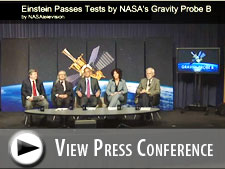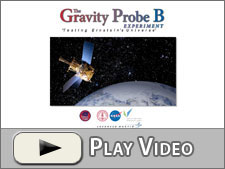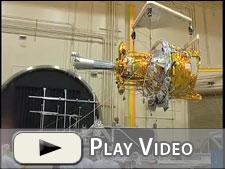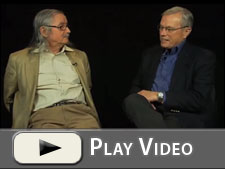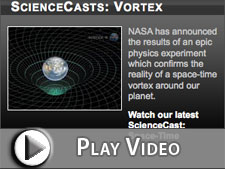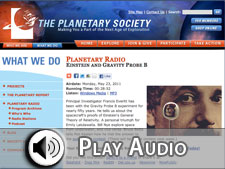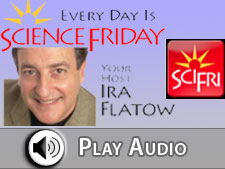GP-B STATUS UPDATE — May 4, 2011
On this page:
Summary of Final GP-B Experimental Results
After 31 years of research and development, 10 years of flight preparation, a 1.5 year flight mission and 5 years of data analysis, our GP-B team has arrived at the final experimental results for this landmark test of Einstein’s 1916 general theory of relativity. Here is the abstract from our PRL paper (see next section) summarizing the experimental results.

Einstein's predicted geodetic and frame-
dragging
effects, and the Schiff Equation
for calculating them.
(Click to enlarge image.)
Gravity Probe B, launched 20 April 2004, is a space experiment testing two fundamental predictions of Einstein's theory of General Relativity (GR), the geodetic and frame-dragging effects, by means of cryogenic gyroscopes in Earth orbit. Data collection started 28 August 2004 and ended 14 August 2005. Analysis of the data from all four gyroscopes results in a geodetic drift rate of -6,601.8±18.3 mas/yr and a frame-dragging drift rate of -37:2±7.2 mas/yr, to be compared with the GR predictions of -6,606.1 mas/yr and -39.2 mas/yr, respectively ('mas' is milliarc-second; 1 mas= 4.848 X10-9 radians or
2.778 X10-7 degrees).
The table and diagram below show the individual gyroscope results, the weighted average results for all four gyroscopes combined, and the theoretical predictions for both effects from Einstein's general theory of relativity, as calculated by Stanford physicist, Leonard Schiff.
Note: The individual and combined statistical uncertainties are corrected for the "over" and "under" dispersion using the Χ2 of the individual estimates in the N-S and W-E directions. Please see our PRL paper (next section below) for more detailed information about these results and their derivation.
| Gravity Probe B — Final Experimental Results | ||
|---|---|---|
| Gyroscope | rN-S (Geodetic Measurement) | rW-E (Frame-Dragging Measurement) |
| Individual Gyroscope Results | ||
| Gyroscope #1 | -6,588.6±31.7 mas/yr | -41.3±24.6 mas/yr |
| Gyroscope #2 | -6,707.0±64.1 mas/ yr | -16.1±29.7 mas/yr |
| Gyroscope #3 | -6,610.5±43.2 mas/yr | -25.0±12.1 mas/yr |
| Gyroscope #4 | -6,588.7±33.2 mas/yr | -49.3±11.4 mas/yr |
| Weighted-Average Results for All Four Gyroscopes | ||
| All Gyroscopes | -6,601.8±18.3 mas/yr | -37.2±7.2 mas/yr |
| Schiff-Einstein Predicted Theoretical Values | ||
| Theoretical Gyroscope | -6,606.1 mas/yr | -39.2 mas/yr |
In the diagram above, the area inside each colored ellipse represents a 95% confidence interval for one gyroscope's measurement of both the N-S (geodetic) and the E-W (frame-dragging) measurements. In other words, the height of each colored ellipse represents a 95% confidence interval for the N-S (geodetic) measurement and the width of each ellipse represents a 95% confidence interval for the W-E (frame-dragging) measurement. The black ellipse shows the weighted average of these measurements for all four gyroscopes combined. The black star in the center of the black ellipse is the actual location of Einstein's predicted geodetic and frame-dragging values.
Gravity Probe B Physical Review Letters (PRL) Paper
On behalf of the GP-B team, Principal Investigator, Francis Everitt, submitted a paper summarizing the GP-B experiment, flight mission, data collection, instrument calibration, data analysis and the final results to PRL in mid-April. The paper is entitled: Gravity Probe B: Final Results of a Space Experiment to test General Relativity. This paper was peer-reviewed, resulting in a few suggestions for minor revisions and clarifications. The revisions were made, and the final draft was then sent to PRL on 28 April 2011. The manuscript was accepted for publication on 1 May 2011 and was published in PRL on 31 May 2011, along with a companion APS Physics Viewpoint article by Clifford Will, entitled Finally, results from Gravity Probe B.
| Gravity Probe B PRL Paper and APS Physics Viewpoint | |
|---|---|
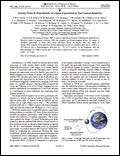 |
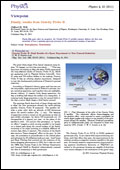 |
| View/Download PRL Paper ( PDF) | View/Download Clifford Will's Physics Viewpoint (PDF) |
Note: We have also posted a copy of the paper to the General Relativity and Quantum Cosmology Section (GR-QC) of arXiv.org. This submission, dated 17 May 2011 is numbered arXiv:1105.3456v1. You can download and view a PDF copy of this arXiv submission at: http://arxiv.org/abs/1105.3456
NASA Headquarters Science Update/Press Conference
On 4 May 2011, NASA Headquarters in Washington DC hosted a 50-minute GP-B Science Update for the purpose of announcing the final experimental results to the press, media and the public. This event, which was televised live on NASA TV and streamed live from the NASA TV website, featured NASA Science Mission Directorate Public Affairs Officer, Trent Perrotto as moderator, GP-B Principal Investigator, Francis Everitt who announced the final results, and four other panelists who discussed various aspects of the program, its many accomplishments and the significance of the results to physicists and the scientific community at large.
In order of their presentations, the panelists included:
- Bill Danchi, Senior Astrophysicist and GP-B Program Scientist at NASA Headquarters. Dr. Danchi provided a general overview of the GP-B experiment and mission
- Francis Everitt, Principal Investigator of GP-B and Research Professor in the WW Hansen Experimental Physics Lab (HEPL) at Stanford University. In addition to announcing the experimental results, Professor Everitt described the two general relativity effects that were measured, provided many details and anecdotes about the experiment, the flight mission, the complications discovered in the data, and the "detective story" of identifying the sources of these complications and ultimately removing these complications to achieve credible results.
- Rex Geveden, President of Teledyne-Brown Engineering and former NASA Marshall Space Flight Center Program Manager for GP-B. Mr. Geveden spoke about the innovations, development and spin-offs of the many new technologies that were developed for use in the GP-B experiment and spacecraft.
- Colleen Hartman, Senior NASA Advisor and Research Professor at George Washington University. Professor Hartman, who had been the the NASA Heaqdquarters Program Executive for GP-B during a critical four-year period leading up to the flight development phase of the mission, spoke about the history and management of GP-B. Professor Hartman closed her remarks with a quote from Albert Einstein about tenacity and persistence that typifices the GP-B program.
- Clifford Will, James S. McDonnell Professor of Physics and Chairman of the GP-B Science Advisory Committee. Professor Will discussed the role of the the NASA-sponsored, external GP-B Science Advisory Committee, which he chaired for the past 13 years, the data analysis issues and their resolution by the GP-B team, and the significance of the GP-B experiment—both in terms of scientific inquiry in general and specifically the relevance of the frame-dragging result to some of the most "energetic and cataclysmic events in the universe."
The presentations lasted about 35 minutes and were followed by 15 minutes of questions and answers, both from reporters, journalists and other members of the audience at NASA Headquarters and also from reporters and journalists linked in from other NASA facilities around the country.
You can click on the video playback icons above to view YouTube video clips containing a "nutshell" overview of the program and results, plus video file segments about GP-B technology development and discussions betweeen PI Francis Everitt and Co-PI Brad Parkinson about various aspects of the program.
Press Releases and Message from Stanford President Emeritus Donald Kennedy
Press Releases
Each of the three GP-B collaborative institutions—Stanford, NASA and Lockheed Martin—prepared press releases for the results announcement. Click any of the links below to view these press releases respectively.
| Gravity Probe B Final Results Press Releases | |||||
|---|---|---|---|---|---|
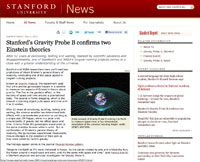 |
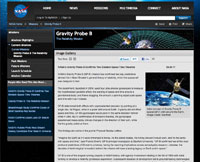 |
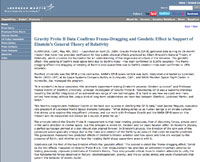 |
|||
| Stanford Press Release ( PDF) | NASA Press Release (PDF) | Lockheed Martin Press Release (PDF) | |||
Message from Stanford President Emeritus Donald Kennedy
Professor Donald Kennedy was president of Stanford University from 1980-1992, the phase of the GP-B program in which the flight hardware was developed and tested, leading directly to the commencement of the GP-B flight mission in 1994. On the occasion of the GP-B Press Conference and Final Results Announcement at NASA Headquarters in Washington DC of 4 May 2011, President Emeritus Kennedy prepared a message to the Stanford community—and the world—about GP-B, Francis Everitt and the GP-B team.
News and Media Coverage
The GP-B Science Update and announcement of the final experimental results at NASA Headquarters on 4 May 2011 generated a considerable amount of press and media coverage. The table below summarizes this press and media coverage to date, including links to each story, as well as links to PDF copies or media files of these stories.
LINKS TO OTHER GP-B TOPICS
- GP-B Frequently Asked Questions (FAQ)
- Track the satellite in the sky
- Build a paper model of the GP-B Spacecraft
- Our mailing list—receive GP-B status updates via email
- View a Flash
video of Professor Everitt's 18 May 2006 lecture on GP-B
Note: Both audio-only and video versions of this lecture are also available on the Stanford on iTUNES U Web site. This Web page automatically launches the Apple iTunes program on both Macintosh and Windows computers, with a special Stanford on iTunes U "music store," containing free downloads of Stanford lectures, performances, and events. Francis Everitt's "Testing Einstein in Space" lecture is located in the Science & Technology—Engineering section. People with audio-only iPods can download the version under the Audio tab; people with 5th generation (video) iPods can download the version under the Video tab.
Previous Update | Index of Updates


